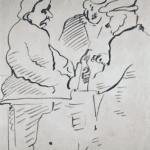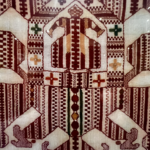<em>Around the Tree: Holiday Traditions in the Soviet Era</em> will bring together artworks and historical artifacts that highlight the unique traditions of the New Year celebration during Soviet rule, a period when Christmas was banned as a religious holiday. The display will include paintings, antique ornaments, masks and more. Click ‘read more’ for more details.<!–more–>
Before the Revolution of 1917, Russian Christmas shared its celebratory spirit with many other European traditions. Solemn church services, gift-giving, caroling, and family feasts were its salient features. Peter the Great is credited with importing the custom of decorating a Christmas tree from Europe. Under the atheist Communist government, all religious holidays were abolished, and by the late 1920s, decorating a tree on New Year’s eve became a suspect and indeed anti-Soviet activity. In Soviet anti-religious propaganda, Christmas trees were labeled as a ‘savage custom’ and ‘religious dope.’
In December 1935, a small article by a prominent Party functionary appeared in the leading Communist Party newspaper Pravda. In this truly sensational article, the author Pavel Postyshev wrote, “It is time to put an end to this wrongful condemnation of the tree. Children’s New Year trees should be everywhere — in schools, orphanages, young pioneer clubs, cinemas, and theaters!”
In the mid-1930s, Soviet domestic policies took a marked turn towards ‘traditionalism.’ As the birthrates continued to fall, Stalin’s attention focused on the family and children. The restoration of the holiday tradition was to serve as proof of Stalin’s famous dictum of 1935, “Life has become better, life has become merrier.” However, Postyshev did not live to see many happy returns of the season: within two years, he perished in the Stalinist prisons.
When the idea of a holiday tree was voiced on the pages of the Pravda, in the Stalinist idiom it was not a recommendation, but rather a command. Very soon, children’s toy factories began to produce tree ornaments, garlands, red stars for treetops, figurines of Grandfather Frost and the Snow Maiden. The Kremlin opened its gates to Moscow’s schoolchildren for a New Year celebration called a Yolka (fir-tree in Russian). The tree was back. Losing its religious association, it became a New Year tree.
The exhibition Around the Tree presents over twenty paintings by notable Soviet artists from the collection of Raymond and Susan Johnson and a remarkable selection of Soviet tree ornaments and related objects from the collection of Kim Balaschak.


